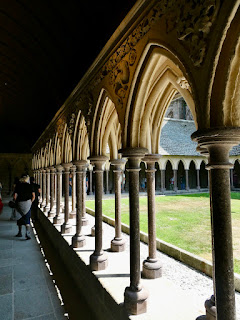Saturday, August 3rd: Yesterday was the fifth day of riding and a very nice one. The roads had little traffic, the elevation changes smaller, and the weather a bit cooler. We rode from Granville to Mont Saint Michel -- 38 miles or 60 kilometers. I tracked closer to 65 kilometers. We did ride out to Mont Saint Michel after arriving instead of taking the shuttle bus; it is about 1.5 miles out to the monastery.
Here are the photos:
Jan and Ron catching up to us.
The first sighting of our destination - Mont Saint Michel.
We rode along the coast for most of the day with only a couple of climbs. This is the view down to Saint Jean le Thomas from Point de Vue.
This is the route we were following.
Mont Saint Michel over corn fields.
Mont Saint Michel from the head of the causeway.
It was low tide with lots of exposed sand. The surrounding bay was described as treacherous, with fast shifting tides and quicksand.
After parking our bikes, we entered the walled "city," fought our way directly up a narrow street (Grande Rue) with typical tourist shops and eateries on both sides, about 100 feet in height and 0.1 mile long. But with the hordes it took some time.
After reaching the ticket line, we continued up steps, purchased entry tickets and rented an 45-minute audio program, and then climbed the last 90 steps to the church entrance. We toured around the monastery (about 12 major rooms) by going up and down steps, through stone hallways, and twisting in numerous directions. The monastery is massive, built on top of the granite island, in the shape of a Roman Cross. There are "pillar rooms" under the church floor supporting the 4 ends of the cross that is the floor plan. They are a forest of large stone columns and were probably crypts originally.
According to the audio history, the first church on this location went back to the 7th century, then a small gothic building was added. The Duke of Normandy funded the final, grand development of the site in the 12th century. It seems there were only 30 to 50 monks resident in the abbey, but pilgrims came in vast numbers and there were many important visitors as well. We saw a huge banquet hall and there must have been many sleeping chambers hidden behind the walls. Another large, well-lit room served as the Scriptorium, where the monks created and copied manuscripts that would have provided revenue.
A telephoto shot of people who are walking over the sand, like true pilgrims. They appear hesitant to cross the water in front of them and are looking back toward the monastery.
The central tower.
A view looking back to the mainland and the causeway.
The highest terrace and outside face of the largest church.
The Cloister, which is on the highest level, next to the church.
The Cloister columns.
A barrel roof in the guest hall.
A walking wheel for hoisting supplies up. The Mont became a prison during the French Revolution and prisoners would walk on the inner rim to power the wheel's rotation.
An aerial shot (photo of a postcard).
The cloister is behind the 3 windows on the upper level.
Back down on the main street.
The view from our hotel room at Le Relais Mont Saint Michel. Mont Saint Michel is peeking up on the left side of the trees.
Dinner at la Ferme Saint Michel.
Additional observations on the bike ride. The country we traversed changed somewhat as we moved westward. The entire area is covered with corn and hay fields, with haying operations in full swing - we frequently had to dodge big, scary, haying rigs. The area near the D-Day beaches had lots of cows, mostly spotted white and black, but some Charolais (tan). As we came toward St. Lo, there were many horses and equestrian facilities (there was even a horse show happening in St. Lo). When we were on the coast, the terrain was reasonably level but inland it was undulating. The coastal land near Mont St. Michel was mostly salt marshes where sheep and a few goats graze. We saw very little forest land. Wildlife sightings consisted of sea gulls, crows, and big wood pigeons, although Betsy spotted 2 ferrets (or weasels) near Utah Beach.
Most residential buildings are constructed of stone, with wooden shutters, and abundant, well-tended flower boxes. After we left Granville we passed through a resort area with many cute holiday homes and pine trees. The villages tend to consist of rows of connected stone buildings, as do most of the farm operations. The stone masonry is universally impressive, and the amount of rocks removed from fields or quarried and then brought to building sites is mind boggling to imagine. We would guess that the stones have been used many times to build structures over the 2,000 or more years this area has been inhabited.





















Looks like another glorious day!! cg
ReplyDeleteAbsolutely enjoying each day . Mary
ReplyDeleteGreat pictures. Sounds like you had a great day as well. ET
ReplyDelete